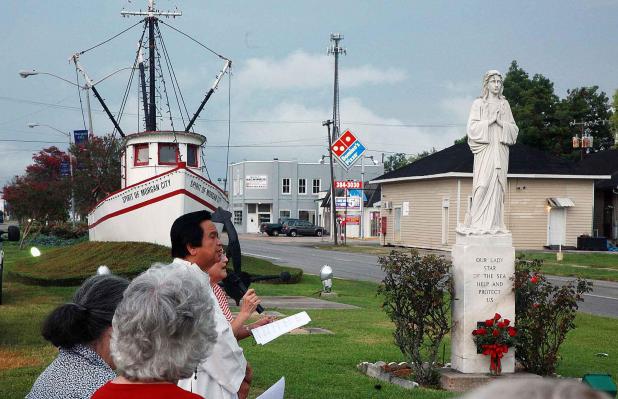
The Daily Review/Bill Decker
The Rev. Freddie Decal leads the July 2018 prayer for safety from hurricanes, an annual event conducted by the Confraternity of Our Lady of the Star of the Sea in Morgan City.
Hurricane forecast: Just about average
Two widely watched hurricane forecasts are slightly at odds over the prospects for tropical weather this season in the Atlantic and Gulf of Mexico. But they agree the season will be something like normal.
Both the Colorado State University Tropical Meteorology Project and AccuWeather, a commercial service to which The Daily Review subscribes, offers a caution: It only takes one hurricane to make a bad season.
The Colorado State program predicts a slightly below-average number of hurricanes and a below-average probability for a major hurricane landfall.
AccuWeather predicts a slightly above-average season: 12-14 storms, five to seven named hurricanes and two to four hurricanes of at least Category 3 strength.
The 2018 season, rated above average, had 15 named storms, eight hurricanes and two major hurricanes — Florence, which struck the Carolina coast, and Michael, which caused widespread damage in the Florida Panhandle. Together, the two storms accounted for more than 100 direct and indirect fatalities and nearly $50 billion in damage.
This year’s more moderate forecasts are based in part on El Niño, the south Pacific warming trend that appears at irregular intervals and can have drastic impacts on U.S. Weather.
The National Oceanic and Atmospheric Administration says the current El Niño is likely to continue at its current weak level through the summer. There are signs that it will strengthen as fall approaches, NOAA said, but that’s not for certain.
Among the effects of El Niño are winds from the west that tend to suppress hurricane formation and intensification.
Some of the storms that do get through during El Niño period have made their mark on history. Audrey in June 1957, which killed hundreds in Cameron Parish, and Andrew in August 1992, which came ashore just west of the Tri-City area after hammering southern Florida, formed during periods with El Niño patterns.
AccuWeather called 1969 an “analog year” with similar conditions to those seen this year. That was the year when Hurricane Camille, one of three Category 5 storms ever to have come ashore in the Unites States, devastated the Gulf Coast in Mississippi and Alabama.
A tropical system becomes a named storm when the maximum sustained winds reach 39 mph. The storm becomes a hurricane when the winds reach 74 mph.
The hurricane becomes Category 3, and is considered major, when the maximum sustained winds reach 111 mph.
But the most lethal part of a hurricane isn’t the wind. It’s the water.
The greatest threat to people on the coast is flooding from the storm surge or storm tide, according to the National Hurricane Center. Inland, the most serious threat comes from flooding resulting from heavy rain, often 6 inches or more, the center said.
